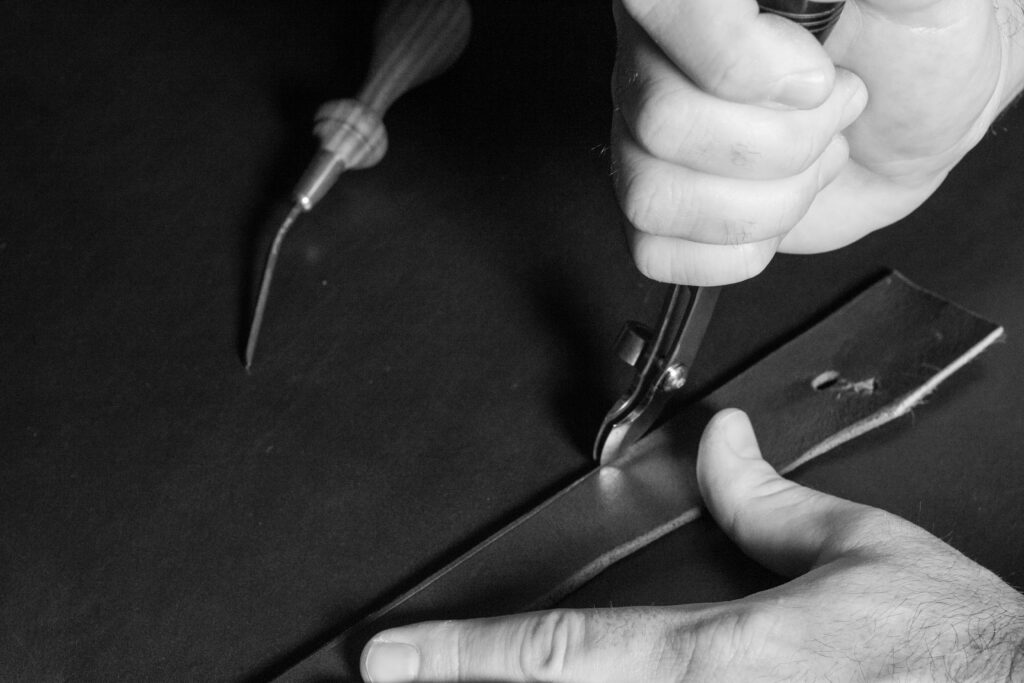Product care
Leather is an investment
Leather goods are an investment because they offer durability, timeless style, and long-term value. Unlike synthetic materials that wear out quickly, high-quality leather develops a rich patina, becoming more beautiful with age. With proper care, leather products can last decades—sometimes even a lifetime—making them cost-effective over time. Their craftsmanship, natural resilience, and ability to be repaired or restored further enhance their longevity. Whether it’s a wallet, bag, or belt, a well-made leather piece is not just an accessory but a lasting statement of quality and sophistication.
Use our care guide to get the most from your investment
Care Guide
Get the most from your investment and make it last a life time.
Like butter spread over too much bread
Excessive stretching of leather products should be avoided because leather is a natural material with fibers that can permanently lose their shape and structural integrity when overstretched. Unlike synthetic materials, leather doesn’t fully regain its original form once stretched, leading to deformation, sagging, and weakened durability. Over time, stretching can also cause the leather to thin out, making it more prone to cracking, tearing, or losing its ability to hold weight properly. This is especially important for bags, wallets, belts, and shoes, where excessive strain can lead to misshaping, loose stitching, or reduced lifespan. To maintain the strength and longevity of leather, it’s best to avoid overloading bags, tightening belts excessively, or stuffing wallets beyond capacity.
Don’t cry over spilled water
If water is spilled on leather, it’s important to act quickly to prevent stains, warping, or damage. Follow these steps to properly care for your leather:
🔹 For Water Stains: If a visible stain remains, gently wipe the entire surface with a damp cloth (not soaking wet) to blend the water stain into the rest of the leather, then let it dry evenly.
🔹 For Severe Water Damage: If the leather becomes stiff, cracked, or misshapen after drying, take it to a professional leather repair specialist for restoration.
1. Blot, Don’t Rub.
Use a soft, dry cloth or paper towel to gently blot the water. Avoid rubbing, as this can spread the moisture and push it deeper into the leather.
2. Air Dry Naturally.
Let the leather air dry at room temperature, away from direct sunlight, heaters, or hairdryers, which can cause the leather to dry too quickly and crack.
3. Condition After Drying.
Once fully dry, apply a small amount of leather conditioner or balm to restore lost moisture and prevent stiffness or cracking.
Why Conditioning Leather Is Important
Leather is a natural material that needs moisture and care to maintain its durability, flexibility, and appearance. Without proper conditioning, leather can dry out, crack, or become brittle, significantly reducing its lifespan.
1. Use the correct conditioner.
-Use a high-quality leather balm, cream, or oil suited for your leather type.
-For vegetable-tanned leather, avoid heavy oils like neatsfoot if you want to maintain its natural color.
-Always test on a small, hidden area first to check for darkening or changes in texture.
2. Clean the Leather First.
-Wipe down with a dry or slightly damp cloth to remove dust and dirt.
-If needed, use a mild leather cleaner and let it dry completely before conditioning.
3. Apply balm or conditioner
-Use a soft, lint-free cloth or sponge to apply a small amount of conditioner.
-Work it in circular motions, allowing it to absorb evenly.
-Focus on dry or worn areas while avoiding oversaturation.
-Allow the conditioner to soak in for a few hours or overnight.
-Buff the leather with a clean, dry cloth to remove excess product and restore shine.
-Condition every 3-6 months for occasional use items (bags, belts, wallets).
How to Remove Scratches on Leather
Scratches on leather can range from light surface marks to deeper scuffs. The best way to fix them depends on the severity of the scratch and the type of leather.
For major damage, professional leather repair may be necessary, but regular care keeps leather looking great for years.
Light Surface Scratches (Shallow & Minor Marks)
–Buff with Your Fingers – Natural oils from your skin can sometimes smooth out light scratches.
–Use a Soft Cloth & Leather Conditioner – Apply a small amount of leather balm or conditioner and rub in circular motions to blend the scratch.
–Buff with a Dry Cloth – After conditioning, gently buff the area to restore the natural shine.
Medium Scratches (Visible but Not Deep)
–Apply Leather Oil or Balm – Use a leather-safe oil (jojoba, mink, or almond oil) or balm to moisturize and soften the area.
–Gently Massage & Blend – Use a soft cloth or your fingers to rub the oil into the scratch in circular motions.
–Let It Absorb & Buff – Allow it to sit for a few hours before buffing with a clean cloth.
Deep Scratches & Scuffs
–Use a Leather Repair Cream – Apply a leather repair compound or filler, specifically designed for deep scratches.
–Let It Dry, Then Buff – Allow the cream to dry completely before buffing to blend with the surrounding leather.
–Reapply if Needed – Multiple applications may be necessary for deep damage.
How to Properly Store Leather
Proper storage is essential to maintain the longevity, flexibility, and beauty of leather goods. Whether it’s a bag, belt, wallet, or jacket, follow these steps to prevent drying, cracking, warping, or mold growth.
Proper storage prevents cracking, fading, warping, or mold, ensuring your leather goods last for decades while aging beautifully!
Store in a Cool, Dry Place
-Keep leather away from direct sunlight, heat, and humidity to prevent fading, drying, or mildew.
-Ideal storage temperature: 60-75°F (15-24°C) with 40-50% humidity.
-Use a dehumidifier or silica gel packs in humid climates to prevent mold.
–Avoid attics, basements, or places near radiators where heat and moisture fluctuate.
Use Breathable Covers, Not Plastic
-Store leather items in a cotton dust bag or pillowcase to allow airflow.
–Avoid plastic bags, as they trap moisture and can cause mold or drying.
Maintain Proper Shape
-Stuff bags with acid-free paper or soft cloth to help retain their form.
-Store belts and straps flat or hung up to prevent curling.
-Lay wallets and small accessories flat to avoid unnecessary bending.
–Avoid overstuffing bags or folding leather items for long periods.
Related Posts
Be the first to know when a new collection is released.
Don’t worry, we don’t have time to send you spammy emails even if we really wanted to. We’re too busy making beautiful products.






